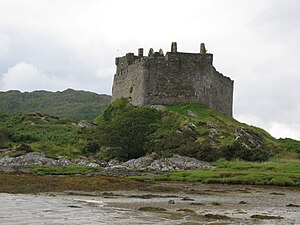Castle Tioram
| Castle Tioram | ||
|---|---|---|
|
Castle Tioram at low tide |
||
| Creation time : | 13th century | |
| Castle type : | Rock castle | |
| Conservation status: | ruin | |
| Place: | Cul Doirlinn | |
| Geographical location | 56 ° 47 '4.5 " N , 5 ° 49' 44.4" W | |
|
|
||
Castle Tioram ( [t͡ʃiːɹəm] : pronounced Tschi-ram , from the Scottish-Gaelic Caisteal Tioram , which roughly means dry castle ) is a ruined castle at Loch Moidart , Lochaber , Highlands , Scotland , which lies on a narrow piece of land that at high tide the tidal island Eilean Tioram forms. It is west of Acharacle , about 50 miles from Fort William . The castle itself is a bit off the open Atlantic and controls access to the inner Loch Moidart and Loch Shiel . It is on the list of Great Britain's National Historic Buildings.
history
After the death of Somerled , the progenitor of the MacDonalds , who united large areas of the Scottish west coast and the offshore islands in the 12th century, his lands were divided between his sons. Moidart became part of the Garmoran Land and was inherited by Christina MacRuari in the 14th century. The castle itself was inhabited without interruption by 14 heads of the Clanranald clan. Evidence of a fortification at this point at the time is provided by a mention in which Arthur Campbell was given land for the service of twenty rowing galleys.
It later became the traditional seat of the Scottish MacDonald clan of Clanranald , a branch of Clan Donald. Castle Tioram was built by King William III's troops around 1692, the year of the Glencoe massacre . occupied by England while clan chief Allan of Clanranald stayed at the court of the Jacobites in France, although he had sworn allegiance to the British crown. A small garrison was stationed in the complex until the Jacobite revolt of 1715. That year Allan recaptured the castle and set it on fire, ostensibly to keep it from falling back into the hands of the royal troops. The castle has remained uninhabited since then. However, there are voices claiming that it was used occasionally afterwards, e.g. B. during the kidnapping of Lady Grange, and that she also served as De Tuillay's arsenal in the 1745 Jacobite revolt.
construction
The outer wall is dated to the 13th century, while the tower and inner buildings are constructions of the 15th to 17th centuries. Amie MacRuari expanded the castle in the 14th century. At that time the building consisted of a pentagonal curtain wall with wooden houses arranged in it. The curtain wall with the barrel vault as the entrance is typical of other 13th century buildings on the Scottish west coast. The masonry consists mainly of local Moine slate in various sizes and shapes, with smaller stones in between, all connected by lime mortar. Clear horizontal lines in the masonry show seasonal breaks in the construction and are particularly well visible on the northeast side. The walls have rounded corners and were built on natural rock without foundations. In several places on the east side there are voids between the lower part of the walls and the floor. Non-local rock, such as slate, was also used in the walls and drainage ducts. The original facade may differ from the present one on the southwest side, where part of the wall is oddly angled. This could indicate a collapse repair.
A rectangular, subsequently closed area describes the position of a side entrance in the eastern section of the wall. Two holes below have held timbers for a platform and steps to the door. Access either existed at an early stage or was added afterwards, but was certainly already blocked in the late 17th century when an oven was built against the inside of this part of the wall.
Current condition
Currently (2011) the castle is in extremely poor condition and was closed to the public at the request of the Highland Council in 1998. In 2000, a major piece of the northwest wall collapsed.
In 1997, controversial proposals by the new owner Lex Brown ( Anta Estates ) to restore the castle became known and he was initially granted planning permission from the Highland Council. The plans included the construction of a clan center (museum) and apartments and should allow public access. However, approval was withdrawn by the state organization Historic Scotland after a local public consultation took place in Acharacle.
The Royal Commission on the Ancient and Historic Monuments in Scotland (RCAHMS) maintains an archive of research papers, drawings and photographs given by the current owners.
The castle can be reached on foot via a dam at low tide. However, due to the risk of collapsing masonry, access to the interior is prohibited.
Individual evidence
- ↑ Sandra Evans: Eilean Tioram (The Dry Island) and Castle Tioram: Amy's castle , accessed April 22, 2011
- ↑ Michael Tierney: The first time he saw Castle Tioram, he almost flew a helicopter into it. Now this ex-RAF pilot says he's fighting to save the Highland landmark. So who is Lex Brown, and why is there such hostility to his (pounds) 4.5 million plans? . In: The Herald Scotland, November 13, 2004, accessed June 9, 2011.
Web links
- Sandra Evans: Eilean Tioram (The Dry Island) and Castle Tioram with detailed descriptions of the various pages and further references (English)
- Entry on Castle Tioram in Canmore, Historic Environment Scotland database
- The Chatelaine's Scottish Castles: Castle Tioram, Moidart / Ardnamurchan ( Memento from February 4, 2012 in the Internet Archive )
- Castle Tioram on the website of Historic Scotland (English)
- Castle Tioram Panorama (English, QuickTime required)



